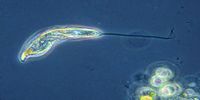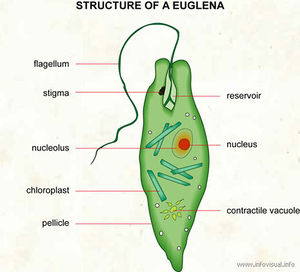Flagellates: Difference between revisions
No edit summary |
No edit summary |
||
| Line 8: | Line 8: | ||
==''Euglena''== | ==''Euglena''== | ||
: '''Cell Structure''' | : '''Cell Structure''' | ||
::Like all Flagellates, Euglena have a flagellum. They are green because they have chloroplasts, which are organelles that aid in photosynthesis and contain chlorophyll. They have a plasma membrane, which contains their cytoplasm and other organelles. A contractile vacuole removes excess water from the cell, and a reservoir located near the flagellum where the excess water is expelled. They also have a red eye spot, called a stigma, which is light sensitive and helps to guide their movement. [[File:Euglena.jpg| | ::Like all Flagellates, Euglena have a flagellum. They are green because they have chloroplasts, which are organelles that aid in photosynthesis and contain chlorophyll. They have a plasma membrane, which contains their cytoplasm and other organelles. A contractile vacuole removes excess water from the cell, and a reservoir located near the flagellum where the excess water is expelled. They also have a red eye spot, called a stigma, which is light sensitive and helps to guide their movement. [[File:Euglena.jpg|left|Euglena|thumb]] | ||
: '''Reproduction''' | : '''Reproduction''' | ||
::During their free swimming life stage, Euglenas reproduce asexually using '''binary fission'''. This process involves parent cell DNA replication, and then it splits into two daughter cells. There is another life stage, however, when environmental conditions become unfavorable. In this case, Euglenas forms a thick-walled cyst to protect themselves until conditions become favorable again. | ::During their free swimming life stage, Euglenas reproduce asexually using '''binary fission'''. This process involves parent cell DNA replication, and then it splits into two daughter cells. There is another life stage, however, when environmental conditions become unfavorable. In this case, Euglenas forms a thick-walled cyst to protect themselves until conditions become favorable again. | ||
Revision as of 10:03, 12 April 2019
Overview

Flagellates are microscopic, unicellular protists. They are characterized by having one or more flagella, which is a hair-like whip organelle and very distinguishable. There are many different types of flagellates, and they all have different lifestyles. Some are make up colonies and others live as single cells. The two main categories are phytoflagellates and zooflagellates. Phytoflagellates are green and plant-like creatures that use photosynthesis to produce food. Zooflagellates are colorless and animal-like. There are some parasitic flagellates, and they fall into this category.
Both phytoflagellates and zoolagellates can be found in ponds, lagoons, and even shallow puddles. Wherever there are large amounts of soluble food, flagellates are there. However, parasitic zooflagellates live inside the intestines or bloodstream of a host and can cause harmful diseases like giardiasis.
Examples
Euglena
- Cell Structure
- Like all Flagellates, Euglena have a flagellum. They are green because they have chloroplasts, which are organelles that aid in photosynthesis and contain chlorophyll. They have a plasma membrane, which contains their cytoplasm and other organelles. A contractile vacuole removes excess water from the cell, and a reservoir located near the flagellum where the excess water is expelled. They also have a red eye spot, called a stigma, which is light sensitive and helps to guide their movement.

Euglena
- Like all Flagellates, Euglena have a flagellum. They are green because they have chloroplasts, which are organelles that aid in photosynthesis and contain chlorophyll. They have a plasma membrane, which contains their cytoplasm and other organelles. A contractile vacuole removes excess water from the cell, and a reservoir located near the flagellum where the excess water is expelled. They also have a red eye spot, called a stigma, which is light sensitive and helps to guide their movement.
- Reproduction
- During their free swimming life stage, Euglenas reproduce asexually using binary fission. This process involves parent cell DNA replication, and then it splits into two daughter cells. There is another life stage, however, when environmental conditions become unfavorable. In this case, Euglenas forms a thick-walled cyst to protect themselves until conditions become favorable again.
Volvox
- Cell Structure
- A volvox is a colony of freshwater algae that forms a hollow ball and can be made up of anywhere from 500-200,000 individual cells. Their flagella are pointed outward, and they move together as one in a spinning motion. They can be big enough to see with the naked eye. The Flagellates are connected by thin strands of cyptoplasm, and can be green, red, or brown.
- Reproduction
References
- [1] Bailey, Regina. “Eugena Cells.” ThoughtCo, 26 Jan. 2018, www.thoughtco.com/about-euglena-cells-4099133.
- [2] "Flagellates.” Environmental Leverage, 2003, www.environmentalleverage.com/Flagellates.htm.
- [3] “Flagellate (Protozoan).” Assignment Point, www.assignmentpoint.com/science/biology/flagellate-protozoan.html.
- [4] Palande, Leena. “Volvox Facts.” Biology Wise, biologywise.com/volvox-facts.
- [5] Setia, Veenu, and Thinley Kalsang Bhutia. “Flagellate.” Britannica, 28 Mar. 2018, www.britannica.com/science/flagellate.